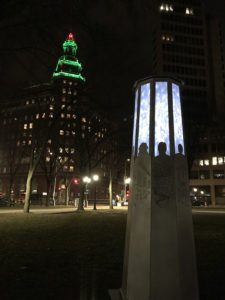The “Yes” of Humanism Glows on the New Haven Green
By Tom Krattenmaker
The Humanist, December 12, 2018
The voice of secular America is often portrayed as the one saying “no” to nativity scenes and other religious displays on public grounds during the winter holidays.
This holiday season, there is a twelve-foot-high lighthouse-shaped sculpture glowing on the city square in downtown New Haven, Connecticut. To Chris Stedman, director of the Humanist Center of Minnesota, it represents a secular “yes”—the affirmative and inclusive voice of humanism.
 Back in 2015, when he was executive director of the Yale Humanist Community (YHC), Stedman initiated the public art project as an attempt to counter the tired “war on Christmas” narrative. While YHC does acknowledge the importance of protecting public spaces from unconstitutional promotions of religion, the community is dedicated to highlighting what nonreligious Americans are for in addition to what they are against.
Back in 2015, when he was executive director of the Yale Humanist Community (YHC), Stedman initiated the public art project as an attempt to counter the tired “war on Christmas” narrative. While YHC does acknowledge the importance of protecting public spaces from unconstitutional promotions of religion, the community is dedicated to highlighting what nonreligious Americans are for in addition to what they are against.
“I was walking through the New Haven Green during my first December as a New Haven resident,” Stedman recalls, “admiring the beautiful lights of the Christmas tree, Menorah, and manger on display in the heart of the city, when it struck me that there might be an opportunity to create something to acknowledge humanist values alongside these religious symbols—a nonreligious work of art that would center and celebrate humanity’s ability to create warmth and light during the coldest, darkest time of the year.
Although not the first or only positive and inclusive secular holiday display in the United States, the New Haven lighthouse sculpture is believed to be the most elaborate and high profile. Bringing it to fruition was a three-year project for the Yale Humanist Community, a New Haven-based nonprofit that serves students at Yale as well as residents of the city and surrounding communities.
The humanist group raised the money through a national fundraising campaign and launched a design competition. Connecticut artist Edwin “Ted” Salmon was selected to create the sculpture.
Although one component was still unfinished, Salmon’s obelisk-shaped sculpture debuted on the New Haven Green in December of 2017—just a half-block away from the huge Christmas tree that draws admirers from across the state. Each of the metal sculpture’s nine sides represents a New Haven neighborhood and shows the silhouette of a person. The sculpture bears an inscription of the YHC logo and vision statement: “People united by values rather than divided by beliefs.”
As head-turning as it was, the lighthouse sculpture was incomplete. Salmon’s design envisioned dynamic, interactive lights inside the obelisk that would respond to the motion of people who approached and moved around the sculpture. The feature had to be shelved initially for lack of funds. A donation by Cary Shaw, a semi-retired management scientist and the founder of Humanists and Freethinkers of Fairfield County, Connecticut, has now paved the way for the addition of that final, missing piece.
To current YHC Executive Director Kathleen Green, the sculpture sends a timely and much-needed message. “Seeing the lights of our humanist seasonal symbol alongside the religious symbols on the Green is a testament to the strength of cooperation in a time when division among disparate groups is dangerously high,” she says. “It is also an expression of inclusion in a time when too many people feel excluded and isolated.”
Stedman, who has been receiving periodic updates on the project, says, “I couldn’t be more thrilled that this project has been completed and that it will go up on the Green for years to come in the way we long envisioned.”
As the Huffington Post noted in an article on the lighthouse project last year, the humanist sculpture’s location on the New Haven Green is particularly striking. Established in 1638, the 16-acre square evinces the long and deeply religious history of the city. (Although privately owned and overseen by a board of proprietors, the New Haven Green functions like a city park.)
The city’s layout is said to have been inspired by the Bible, and today the Green is home to three churches. The religious history of the Green is reinforced during the holiday season by the Christmas tree—sixty feet high this year—and the prominent Menorah.
“We see the lighthouse as a symbol of connection for people who may feel left out during the holidays with the various religious displays that don’t represent them,” Green says. “People often think of a lighthouse as a beacon of hope, and in this case it’s a beacon of warm welcome that lets people know they’re part of this community regardless of where they find themselves on the religious spectrum.”
Tom Krattenmaker is a columnist and author specializing in religion in public life and member of the Board of Directors of the Yale Humanist Community.

